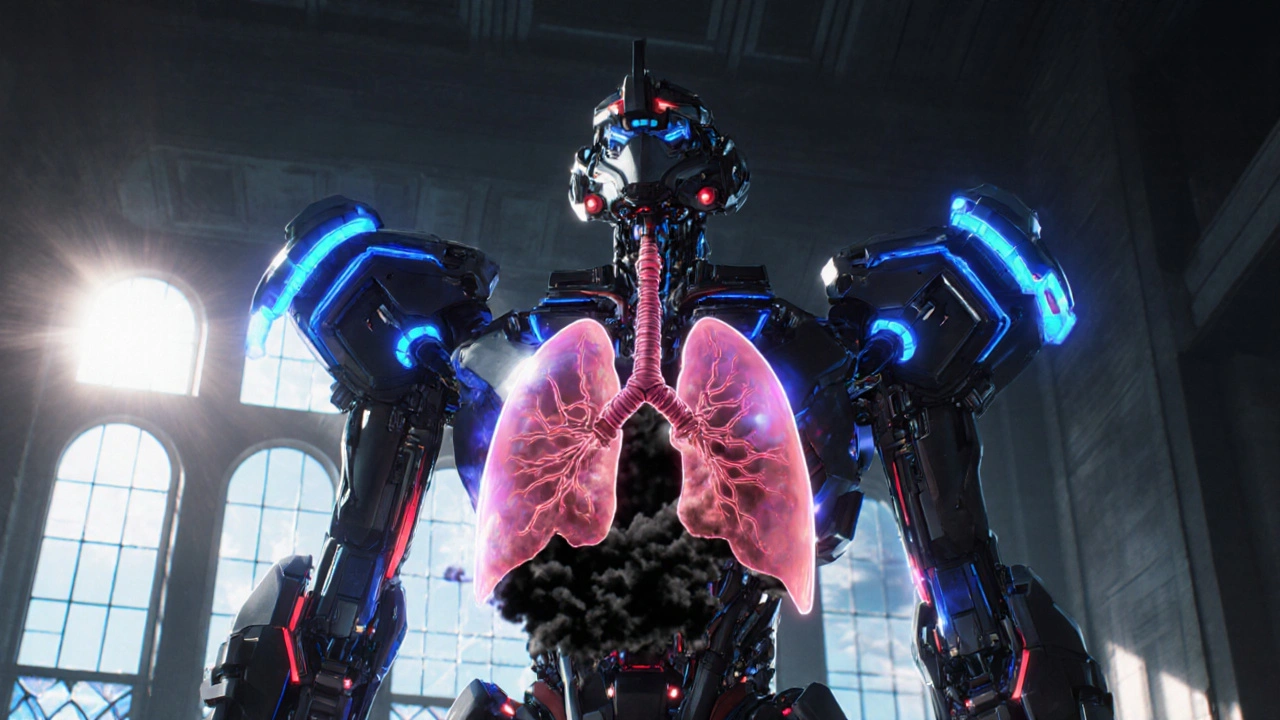IPF Treatment Side Effect Comparison Tool
How This Tool Works
This tool helps you compare Esbriet (pirfenidone) and Ofev (nintedanib) based on your sensitivity to specific side effects. Select your concerns about each side effect, and we'll show you which medication might be better for your situation.
Note: Always discuss treatment decisions with your doctor. This tool is for informational purposes only and doesn't replace medical advice.
Your Recommendation
Remember: This is a general guide. Your doctor will consider your medical history, other medications, and specific needs when determining the best treatment for you.
What is Esbriet and why do people use it?
Esbriet is the brand name for pirfenidone, an antifibrotic and anti-inflammatory medication approved to slow the progression of idiopathic pulmonary fibrosis (IPF). It was first approved by the FDA in 2014 and has since been used by over 100,000 patients worldwide. IPF is a serious lung disease where scar tissue builds up in the lungs over time, making it harder to breathe. Esbriet doesn’t cure IPF, but it helps reduce the rate at which lung function declines.
Most people take Esbriet as three pills a day, with meals to reduce stomach upset. Common side effects include nausea, fatigue, dizziness, skin rash, and sensitivity to sunlight. About 1 in 5 people stop taking it because side effects become too hard to manage.
Why look at alternatives to Esbriet?
Not everyone tolerates Esbriet well. Some patients report constant nausea, even after adjusting the dose. Others get severe sunburns from minimal exposure. A few find the three-times-daily schedule hard to stick with.
When Esbriet isn’t working or isn’t tolerable, doctors often consider other options. The main alternative is nintedanib, sold as Ofev. But there are also off-label drugs, clinical trials, and supportive therapies that matter just as much.
Nintedanib (Ofev): The other FDA-approved IPF drug
Nintedanib (brand name Ofev) is the only other drug approved in the U.S. and Australia for treating IPF. Like Esbriet, it slows lung function decline, but it works differently. While Esbriet targets inflammation and fibrosis through multiple pathways, nintedanib blocks specific growth factors that drive scar tissue formation.
Here’s how they compare:
| Feature | Esbriet (Pirfenidone) | Ofev (Nintedanib) |
|---|---|---|
| How it works | Reduces inflammation and fibrosis | Blocks growth factor receptors |
| Dosing | Three times daily with meals | Twice daily, with food |
| Common side effects | Nausea, fatigue, sun sensitivity | Diarrhea, liver enzyme changes, nausea |
| Drug interactions | Strong CYP1A2 inhibitors (like fluvoxamine) | Strong CYP3A4 inhibitors (like ketoconazole) |
| Monitoring needed | Liver function tests monthly | Liver function tests monthly |
| Effectiveness | Reduces decline by ~30% over 1 year | Reduces decline by ~25-30% over 1 year |
Studies show both drugs are similarly effective at slowing lung function loss. But side effect profiles differ. People who get bad sunburns on Esbriet often switch to Ofev. Those who can’t handle diarrhea on Ofev may go back to Esbriet.
What about other drugs or treatments?
There are no other FDA-approved drugs for IPF besides Esbriet and Ofev. But some doctors use off-label medications in specific cases:
- Immunosuppressants like azathioprine or mycophenolate - used in the past, but now avoided because they increase infection risk and don’t improve survival.
- Antacids like omeprazole - often prescribed because many IPF patients have silent reflux, which may worsen lung damage.
- Colchicine - studied in small trials, but no strong evidence it slows IPF progression.
Some patients try supplements like N-acetylcysteine (NAC), but a large NIH trial in 2014 found it didn’t help when taken with standard care. Don’t waste money on unproven remedies.

Non-drug options: What actually helps?
Medications are just one part of managing IPF. The most important non-drug strategies are:
- Oxygen therapy - helps when blood oxygen drops below 88%. Many patients start using it during activity, then eventually at rest.
- Pulmonary rehab - structured exercise and education programs improve breathing, stamina, and quality of life. Studies show patients who complete rehab walk farther and feel less anxious.
- Smoking cessation - if you smoke, quitting is the single most effective thing you can do. Smoking doubles the rate of lung function decline.
- Lung transplant - for younger, healthier patients with advanced disease. Survival after transplant is about 50% at 5 years, but it’s the only option that can restore normal lung function.
Many patients don’t realize pulmonary rehab is covered by Medicare and most private insurers. Ask your doctor for a referral - it’s not optional, it’s essential.
When should you switch from Esbriet to Ofev?
There’s no hard rule, but most doctors consider switching if:
- You’ve been on Esbriet for 3 months and side effects are still severe (e.g., daily nausea, rash that won’t go away).
- Your lung function (measured by FVC or DLCO) keeps dropping despite taking the full dose.
- You can’t stick to the dosing schedule - missing doses reduces effectiveness.
Switching isn’t a failure. It’s a smart adjustment. Some patients take Esbriet for 6 months, then switch to Ofev and do better. Others go the other way. There’s no right order - just what works for your body.
Never stop either drug suddenly. Both can cause a rapid worsening of IPF if stopped abruptly. Always taper under medical supervision.
Cost and access: What’s affordable?
In Australia, both Esbriet and Ofev are listed on the Pharmaceutical Benefits Scheme (PBS), meaning patients pay around $30 per script with a concession card, or $150 without. In the U.S., without insurance, Esbriet can cost over $10,000 a month. Many patients use patient assistance programs from the manufacturers to reduce costs.
Insurance often requires prior authorization for either drug. Some require you to try one before approving the other. If your insurer denies coverage, ask your doctor to appeal with a letter explaining why the alternative is needed.

What’s coming next? New drugs in the pipeline
Several new drugs are in late-stage trials for IPF:
- PRM-151 - a recombinant protein that helps clear scar tissue. Early results show promise in improving lung function.
- GLPG1690 - targets a protein involved in fibrosis. Phase 3 trials are ongoing.
- Anti-LOXL2 antibodies - block a key enzyme in scar formation. Still in early testing.
These aren’t available yet, but if you’re eligible, ask your pulmonologist about clinical trials. They’re often free and give access to cutting-edge treatments.
Final thoughts: No one-size-fits-all
There’s no single best drug for IPF. Esbriet and Ofev are both effective. The right choice depends on your side effects, lifestyle, and how your body responds. Some people do better on one, some on the other. A few even take both together - but only under close supervision.
What matters most is staying on treatment, avoiding triggers like smoking or infections, and staying active. Medication alone won’t save you - but combined with rehab, oxygen, and smart lifestyle choices, it gives you back control.
Frequently Asked Questions
Can I take Esbriet and Ofev together?
Some doctors prescribe both drugs together in advanced cases, but this is rare and only done under strict monitoring. Combining them increases the risk of liver damage and severe gastrointestinal side effects. Most patients use one or the other. Never combine them without your pulmonologist’s approval.
How long does it take for Esbriet to start working?
Esbriet doesn’t make you feel better right away. It works slowly to slow lung damage. You won’t notice improved breathing, but lung function tests (like FVC) taken after 6-12 months show less decline than expected. The goal isn’t to feel great - it’s to stay stable longer.
Does Esbriet cause weight loss?
Yes, weight loss is common. Up to 25% of patients lose more than 5% of their body weight in the first year. This is often due to nausea and reduced appetite. Your doctor may recommend high-calorie snacks or nutritional supplements to help maintain weight. Losing too much weight can make breathing harder and increase risk of complications.
Is there a generic version of Esbriet?
Yes, generic pirfenidone became available in Australia in 2023 and in the U.S. in 2024. It’s chemically identical to Esbriet and costs significantly less - often under $200 per month with insurance. Ask your pharmacist if your prescription can be switched to generic.
Can I drink alcohol while taking Esbriet?
Moderate alcohol use is usually okay, but heavy drinking increases the risk of liver damage. Since both Esbriet and alcohol are processed by the liver, combining them can raise liver enzyme levels. Most doctors recommend limiting alcohol to one drink per day or avoiding it entirely, especially if you have any signs of liver stress.
What happens if I miss a dose of Esbriet?
If you miss one dose, skip it and take your next dose at the regular time. Don’t double up. Missing doses occasionally won’t ruin your treatment, but frequent missed doses reduce the drug’s effectiveness. Set phone alarms or use a pill organizer to stay on track.
Are there any foods I should avoid with Esbriet?
Avoid grapefruit and grapefruit juice. They interfere with how your body breaks down pirfenidone, which can raise drug levels and increase side effects. Also, avoid strong CYP1A2 inhibitors like fluvoxamine (an antidepressant) or ciprofloxacin (an antibiotic), unless your doctor approves it.
Can Esbriet help with other types of lung fibrosis?
Esbriet is only approved for idiopathic pulmonary fibrosis (IPF). It’s not proven to help with fibrosis caused by autoimmune diseases (like scleroderma), asbestosis, or hypersensitivity pneumonitis. Some doctors use it off-label, but there’s no strong evidence. Always confirm your diagnosis before starting treatment.

Adam Walter
October 28, 2025 AT 05:22Let me tell you something most doctors won’t: pirfenidone’s real magic isn’t in the science-it’s in the timing. The FDA approved it in 2014, but the real story? The patent cliff started in 2023, and suddenly, generics dropped to $200/month. That’s not coincidence. That’s corporate calculus. They knew patients would suffer through nausea and sunburns for years… until the money shifted. Now? Everyone’s switching. But the drug hasn’t changed. The profit margins did.
And don’t get me started on Ofev. Same playbook. Same side effects, different flavor. Diarrhea instead of sunburns. Same efficacy curve. Same corporate sponsors whispering in pulmonologists’ ears. The only thing different? The price tag on the bottle. The science? Still just slowing the inevitable.
Meanwhile, pulmonary rehab? Covered by insurance. Free for most. But nobody talks about it because there’s no pill to sell. No patent to protect. Just sweat, breathing exercises, and dignity. That’s the real treatment. The drugs? Just the glitter on the coffin.
And yes-I’ve seen patients on both. One guy switched from Esbriet to Ofev, then back again. He said, ‘It’s like choosing between two kinds of chains.’ The disease doesn’t care which one you pick. It just waits.
Dr. Alistair D.B. Cook
October 28, 2025 AT 20:31jackie cote
October 29, 2025 AT 16:23Ashley Tucker
October 30, 2025 AT 23:21Michael Lynch
October 31, 2025 AT 07:26Camille Mavibas
November 1, 2025 AT 21:16Melissa Thompson
November 2, 2025 AT 20:16Gurupriya Dutta
November 3, 2025 AT 17:50John Greenfield
November 3, 2025 AT 19:02Allen Jones
November 5, 2025 AT 09:57Hollis Hamon
November 5, 2025 AT 20:20ANDREA SCIACCA
November 6, 2025 AT 15:11Lee Lee
November 6, 2025 AT 20:15caroline howard
November 7, 2025 AT 08:05Shubham Singh
November 8, 2025 AT 00:11